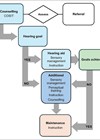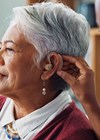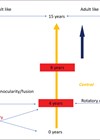This review explores the significance of extended high-frequency hearing loss (above 8 kHz) and why it may be worth doing clinically more frequently.
There are many conditions that may hide underneath a normal audiogram, and one of the easiest to find is hearing loss in the extended high frequencies (EHFs; >8 kHz). Let’s review 10 key findings from the research on EHFs.
1. Hearing loss in EHFs can occur despite a normal audiogram, and it is widespread.
In the last decade, there has been increased focus on identifying and addressing non-traditional forms of hearing loss, including subclinical, slight, and hidden hearing loss. EHF hearing loss is a notable example of this emerging area of clinical practice.

Figure 1: Audiogram with extended high frequencies (12.5 and 16 kHz).
Figure 1 illustrates a conventional or standard audiogram (green shaded area) that is considered normal, with hearing thresholds ≤20 or 25 dB HL at frequencies 0.25 to 8 kHz. However, when hearing thresholds are measured at 12.5 and 16 kHz (cyan shaded area), the blue curve remains within normal limits, but the red curve precipitously drops. This condition is called EHF hearing loss, a type of subclinical or hidden hearing loss. Estimates suggest that 19–58% of individuals aged 18–38 years, who otherwise have normal audiograms, experience EHF hearing loss [1,2].
2. Hearing acuity in the EHFs may indeed matter in difficult listening situations.
One long-standing mystery in audiology and hearing sciences is that some individuals report difficulties with listening in noisy environments, despite having normal audiograms. EHF hearing loss could potentially be the missing link, at least for some of these cases. EHF cues might be valuable in cocktail party listening scenarios, and loss of EHF hearing could be associated with poorer speech-in-noise recognition [1–3]. Importantly, individuals with EHF hearing loss also self-reported diminished functional listening abilities, suggesting that loss in EHF hearing can impact daily auditory experiences [4].
3. The causative factors of EHF hearing loss are not new.
EHF hearing loss shares many of the exact causes of sensorineural hearing loss, including factors such as ageing, noise exposure and ototoxicity. A decline in EHF hearing could be an early indicator of age-related hearing changes, signalling potential damage before it becomes evident in the audiogram. Noise exposure impacts EHF hearing, especially in the early stages. In children, recurrent otitis media has been associated with elevated EHF thresholds, even after the condition has resolved [5]. This suggests that early damage to the cochlea may manifest as reduced EHF hearing.
"Unlike many research innovations that remain inaccessible, EHF tests can be easily performed using existing equipment in clinics"
4. EHF hearing loss is a marker for subsequent clinical hearing loss.
Hearing thresholds in the EHFs have been shown to be predictive of hearing status in the standard frequency range for both adults and children [1,2,6]. Moreover, otoacoustic emissions in the standard frequency range are lower in adults with EHF hearing loss compared to those without [2,7]. This suggests that EHF hearing status may serve as an early marker of pre-clinical cochlear damage, potentially predicting the onset of clinical hearing loss later in life. While some studies have suggested a possible link between EHF hearing loss, cochlear synaptopathy and tinnitus, the current evidence is not compelling and requires further investigation.
5. EHF hearing loss could alter speech development.
Children are exquisitely sensitive to EHFs. Studies have reported the prevalence of EHF hearing loss ranging from 7–32% in school-aged children [6–8]. Reduced EHF hearing has been associated with speech sound disorders and difficulties with phonemic discrimination in noise. This suggests that EHF hearing loss during critical periods of speech development could negatively impact speech production in young children. Additionally, some research indicates that children who experience listening difficulties, often referred to as having auditory processing disorders, may also have underlying EHF hearing loss [9]. These findings highlight the importance of EHF hearing in the development of speech and listening skills.
6. Potential links between EHF hearing loss and associated health risks.
Interestingly, some evidence suggests a link between asymmetry in EHF thresholds between ears and global executive functions, specifically response inhibition in adults with normal audiograms [10]. Given the longitudinal association between individual differences in hearing up to 25 dB HL and performance in certain cognitive tasks (Letter Fluency test) [11], it is plausible that subtle changes in cognitive performance are present before the traditional threshold for abnormal hearing is reached. Of course, this hypothesis needs further experimentation.
7. Calibration standards do exist for EHFs.
Both American (ANSI S3.6-2010) and international standards (ISO 389-5:2006; ISO 389-1:2017) provide reference equivalent threshold sound pressure levels and support the calibration of EHFs. Test-retest reliability of thresholds at EHFs is comparable to that in the standard audiometric frequencies for both adults and children. A lesser-known fun fact is that the first commercially available audiometer (Western Electric 1A, in the early 1920s) came with testing capabilities up to 16 kHz.
8. Currently, there are no hearing aid solutions to EHF hearing loss.
While extended bandwidth hearing aids are under development [12], they are not intended for cases with selective EHF loss as these individuals have clinically normal audiograms. However, efforts are underway to test the efficacy of low-gain hearing aids for listening-in-noise deficits in clinically normal hearing adults [13]. An important step would be to monitor the hearing status of these individuals so that early interventions can be applied when hearing loss occurs.
9. Audiologists don’t need new technology or additional training to incorporate EHF hearing tests into their clinical practice.
Unlike many research innovations that remain inaccessible, EHF tests can be easily performed using existing equipment in clinics. Audiometers already available in most clinics and school hearing screening programmes can be adapted for EHF testing, though some may need to add the EHF range. If time constraints are a concern, testing just at 16 kHz could still provide valuable insights. Ultimately, the decision to test EHFs should be made on a case-by-case basis. For example, it is unnecessary to test hearing for EHFs for someone with severe-to-profound hearing loss.
10. The next thing in EHF hearing.
While significant progress has been made in understanding EHF hearing loss, the impact of selective EHF impairment on neural and brain mechanisms remains an area of active research. Future studies employing machine learning techniques may enable precise prediction of future hearing loss based on EHF thresholds in an individual. This breakthrough will be highly beneficial to clinicians and lead to earlier identification and intervention of hearing loss.
References
1. Motlagh Zadeh L, Silbert NH, Sternasty K, et al. Extended high-frequency hearing enhances speech perception in noise. Proc Natl Acad Sci USA 2019;116(47):23753–9.
2. Mishra SK, Saxena U, Rodrigo H. Extended High-frequency Hearing Impairment Despite a Normal Audiogram: Relation to Early Aging, Speech-in-noise Perception, Cochlear Function, and Routine Earphone Use. Ear Hear 2022;43:822–35.
3. Braza MD, Corbin NE, Buss E, Monson BB. Effect of Masker Head Orientation, Listener Age, and Extended High-Frequency Sensitivity on Speech Recognition in Spatially Separated Speech. Ear Hear 2022;43:90–100.
4. Saxena U, Mishra SK, Rodrigo H, Choudhury M. Functional consequences of extended high frequency hearing impairment: Evidence from the speech, spatial, and qualities of hearing scale. J Acoust Soc Am 2022;152(5):2946–52.
5. Hunter LL, Margolis RH, Rykken JR, et al. High frequency hearing loss associated with otitis media. Ear Hear 1996;17(1):1–11.
6. Mishra SK, Saxena U, Rodrigo H. Hearing impairment in the extended high frequencies in children despite clinically normal hearing. Ear Hear 2022;43:1653–60.
7. Mishra SK, Rodrigo H, Balan JR. Exploring the Influence of Extended High-Frequency Hearing on Cochlear Functioning at Lower Frequencies. J Speech Lang Hear Res 2024;67:2473–82.
8. Hunter LL, Blankenship CM, Linet L, et al. Peripheral Auditory Involvement in Childhood Listening Difficulty. Ear Hear 2021;42(1):29–41.
9. Petley L, Hunter LL, Zadeh M, et al. Listening Difficulties in Children With Normal Audiograms: Relation to Hearing and Cognition. Ear Hear 2021;42(6):1640–55.
10. Brännström KJ, Karlsson E, Waechter S, Kastberg T. Extended high-frequency pure tone hearing thresholds and core executive functions. Int J Audiol 2018;57(9):639–45.
11. Irace AL, Armstrong NM, Deal JA, et al. Longitudinal Associations of Subclinical Hearing Loss With Cognitive Decline. J Gerontol A Biol Sci Med Sci 2022;77(3):623–31.
12. Whitmer WM, McShefferty D, Levy SC, et al. Changes in Orientation Behavior due to Extended High-Frequency (5 to 10 kHz) Spatial Cues. Ear Hear 2022;43(2):545–53.
13. Singh J, Doherty KA. Use of a Mild-Gain Hearin g Aid by Middle-Age Normal-Hearing Adults Who Do and Do Not Self-Report Trouble Hearing in Background. Noise Am J Audiol 2020;29(3):419–28.
Declaration of competing interests: None declared.











